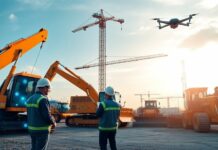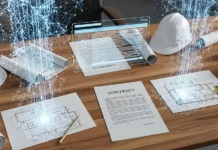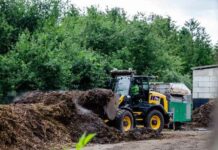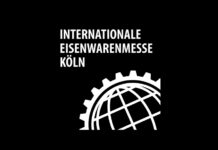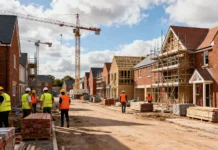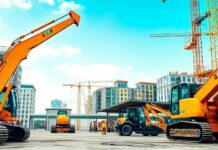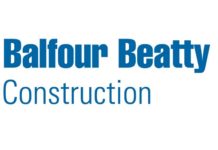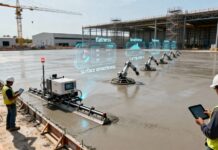Large-scale concrete slab construction has long relied on manual finishing labor, a physically demanding and skill-dependent process vulnerable to inconsistent results across expansive surfaces. Workers wielding power trowels and screeds spend extended shifts applying uniform pressure and achieving flatness specifications across warehouse floors, airport pavements, parking structures, and industrial facilities. The variability inherent in manual operations, combined with operator fatigue, environmental stresses, and the difficulty of achieving specification compliance across massive surfaces, created persistent quality challenges that affected long-term durability and functionality. Automated concrete finishing systems represent a revolutionary response to these challenges, introducing precision, consistency, and productivity that transcend manual labor capabilities while fundamentally transforming slab construction economics and quality outcomes.
Laser Screed Technology and Its Transformative Applications
Laser screeding equipment emerged from recognition that manual concrete leveling introduced unacceptable variability in large-scale projects where flatness specifications demanded exceptional precision. Traditional screeds relied on straightedge guides establishing reference planes through string lines, sight levels, or mechanical reference systems. Laser screeding replaced these mechanical references with laser beams establishing perfectly straight, level references across expansive surfaces regardless of distance or terrain complexity. The technology proved revolutionary for applications including airport runways, industrial warehouse floors, and logistics centers where even minor deviations from specification create operational problems or safety hazards.
The laser screed system comprises several integrated components working in concert to achieve automated leveling. A laser transmitter establishes a precision reference plane, with receiver sensors mounted on the screed head continuously detecting laser beam position. Control systems compare actual screed position against the laser reference and automatically adjust the screed elevation through hydraulic mechanisms, maintaining target grades with millimeter-level precision. Operators guide the screed across the concrete surface at controlled speeds while the automated elevation adjustment system handles the complex task of maintaining exact specifications throughout the pour. This automation eliminates human operator error that previously compromised result consistency.
The productivity improvements delivered by laser screeding systems prove remarkable compared to manual methods. Equipment deployment across expansive floor surfaces allows completing coverage rates exceeding traditional approaches by factors of three to five. A large warehouse floor pour that might require multiple weeks of manual leveling and troweling can reach completion within days using laser screeding technology. The speed advantages compound across projects as equipment operates continuously under controlled conditions without fatigue limitations affecting worker productivity. Smaller project teams achieve coverage rates previously requiring significantly larger labor forces, dramatically improving construction economics.
Flatness and smoothness specifications achieved through laser screeding exceed manual labor capabilities, establishing new industry standards for surface quality. The consistent pressure and precisely maintained grades characteristic of automated systems produce surfaces with flatness values approaching specification limits, eliminating variations that require remedial grinding or polishing. The resulting surfaces exhibit uniform reflectivity and aesthetic qualities superior to manually-finished alternatives. These quality improvements directly translate to enhanced facility functionality, reduced operational difficulties, and improved long-term durability characteristics.
Robotic Troweling Systems and Advanced Finishing Capabilities
Robotic trowel systems represent the next evolution in concrete finishing automation, addressing the final phase of slab construction where power trowels compact and smooth fresh concrete surfaces. Ride-on power trowels operated by skilled workers provided improvements over walk-behind equipment, but still required operator skill and experience to maintain consistent results across entire floor expanses. Robotic systems eliminate operator variables through automated control of blade speed, angle, and pressure, delivering uniform finishing regardless of surface area or concrete characteristics.
The physical design of robotic troweling systems reflects specialized requirements for reliable operation on freshly-placed concrete. Caterpillar or wheeled drive systems distribute equipment weight across large surface areas, preventing sinking into partially-set concrete while maintaining mobility across expansive floors. Multiple rotating trowel blades with variable speed control adapt to changing concrete consistency as material sets progressively. Advanced sensor systems monitor concrete curing stages and optimize trowel operations accordingly, adjusting blade speeds and patterns to achieve desired surface characteristics as concrete strength development progresses.
One particularly innovative robotic finishing approach employs four-piece trowel systems rotating around centrally-mounted caterpillars, with trowels working in coordinated patterns to achieve uniform surface compaction and smoothing. The system produces surface quality comparable to work by experienced plasterers while covering expansive areas at production rates reaching 300 square meters per hour. This productivity advantage, combined with consistency elimination of operator fatigue effects, demonstrates the transformative potential of robotic finishing systems for large-scale slab construction.
The integration of GPS guidance and automated control systems enables robotic trowels to work autonomously across defined work areas with minimal human intervention. Operators program equipment parameters based on concrete characteristics and desired finish specifications, then systems execute according to plan with continuous sensor feedback adjusting operations in real-time. This level of automation reduces labor requirements from crews of multiple skilled trowel workers to a single system operator managing multiple pieces of equipment, delivering dramatic cost reductions alongside superior result consistency.
Integrated Laser and Robotic Systems for Comprehensive Slab Solutions
The most advanced slab construction implementations combine laser screeding for initial leveling with robotic trowel systems for subsequent finishing operations, creating integrated workflows optimizing both speed and quality. Laser screeding establishes precise grade references and initial surface leveling as concrete sets to appropriate consistency. Robotic trowels subsequently process surfaces achieving specified flatness values and aesthetic finishes. This sequential workflow, with each specialized system optimized for its specific function, produces results exceeding what either technology achieves independently.
The coordination between laser and robotic systems involves sophisticated timing management ensuring each system operates at optimal stages of concrete development. Scheduling algorithms account for concrete strength gain rates, environmental temperature and humidity conditions, and project-specific pour sequences. Real-time monitoring systems tracking concrete curing progress trigger equipment deployment at ideal times, maximizing efficiency while ensuring quality outcomes. Building information modeling systems increasingly incorporate concrete finishing system scheduling, enabling projects to optimize equipment deployment and labor allocation throughout construction phases.
Digital control systems integrating laser screeding and robotic troweling create data-rich environments generating insights about concrete performance and process efficiency. Continuous monitoring records elevation profiles, finishing progress, concrete strength development trajectories, and system performance metrics. This data enables quality verification, identifies opportunities for process optimization, and provides documentation supporting quality assurance requirements. Machine learning algorithms analyzing accumulated historical data progressively improve process predictions and parameter optimization, enhancing results as systems gain operational experience across multiple projects.
Performance Outcomes and Specification Compliance
Automated concrete finishing systems achieve flatness values, smoothness characteristics, and durability outcomes that exceed most manual labor capabilities, establishing new quality standards across the industry. FF flatness and FL levelness ratings, standardized metrics quantifying surface characteristics, consistently reach specification limits with automated systems while manual operations frequently struggle to achieve target values. Superior surface quality directly translates to enhanced facility functionality, reduced operational complications, and improved long-term durability through reduced water ponding and premature wear patterns associated with surface irregularities.
The dense, uniformly-compacted surfaces produced by consistent robotic finishing exhibit enhanced wear resistance, reduced permeability, and improved resistance to environmental stresses. Industrial facilities deploying robotic finishing report reduced maintenance requirements and extended floor service life compared to facilities with manually-finished surfaces. The economic value of these durability improvements compounds over infrastructure service lives, often justifying significant investments in automated finishing systems through lifecycle cost analyses.
Quality control and specification verification become simpler and more objective with automated systems. Rather than relying on subjective assessments and manual flatness measurements at limited locations, automated systems generate continuous documentation of achievement across entire surfaces. Portable 3D scanning equipment can verify finished surface conformance with specifications, generating detailed profiles confirming flatness achievement or identifying areas requiring remedial work. This comprehensive verification approach provides confidence in quality outcomes and documents compliance for project records and owner acceptance.
Economic Analysis and Return on Investment Considerations
The economic case for automated concrete finishing systems varies significantly based on project scale, surface area, frequency of utilization, and cost of financing or renting equipment. Large-scale projects with extensive floor areas achieve favorable returns through dramatic labor cost reductions and productivity improvements. A warehouse project covering 50,000 square meters completes in a fraction of the time requiring traditional manual finishing, with smaller labor teams and superior results. The schedule acceleration benefits prove particularly valuable in industrial facilities where operational delays translate directly to economic losses.
Equipment costs represent significant considerations in adoption decisions. Laser screeds and robotic trowel systems represent substantial capital investments, particularly for smaller contractors or specialized applications with limited utilization opportunities. Equipment rental and leasing models provide alternatives for projects where capital investment proves prohibitive, enabling access to technology benefits without permanent asset acquisition. As equipment markets mature and competition expands, rental costs have declined significantly, improving project economics for contractors unable or unwilling to commit capital to equipment ownership.
Labor cost impacts extend beyond simple wage reductions to encompass broader economic factors including training requirements, supervision, and benefits considerations. Skilled equipment operators command premium wages reflecting specialized expertise, but single operators can manage multiple machines previously requiring crew teams. Overall labor costs typically decline 30 to 50 percent compared to manual approaches while simultaneously reducing physical demands on workers and improving safety outcomes. The combination of reduced labor requirements and improved safety characteristics creates compelling economic justifications alongside quality and productivity benefits.
Lifecycle cost analyses demonstrate sustained economic advantages as facilities benefit from improved durability and reduced maintenance requirements. Superior flatness and smoothness characteristics reduce operational problems in warehouses where equipment must track precisely along floors, or airports where even small surface irregularities can damage aircraft. Reduced maintenance costs accumulate over years of facility operation, often exceeding initial equipment investment advantages within relatively short timeframes. For facility owners evaluating long-term infrastructure value, automated finishing systems frequently represent wise investments despite initial cost premiums.
Implementation Challenges and Future Development
Widespread adoption of automated concrete finishing systems encounters several persistent challenges including operator skill requirements, regional equipment availability, and integration with existing construction workflows. Operators of laser screeding and robotic systems require training in specialized technologies, sensor management, and process optimization. While the learning curve is relatively manageable for experienced concrete workers, training investments remain necessary for workforce development. Professional certification programs and manufacturers’ training courses increasingly address this need, but standardization of certification requirements and training content remains incomplete across regions.
Environmental conditions significantly impact automated system performance and require consideration during project planning. Laser systems function reliably in most weather conditions, though direct sunlight can occasionally reduce receiver visibility. Robotic systems operate effectively across temperature and humidity ranges typical of outdoor construction, though extreme conditions can affect equipment performance. Concrete characteristics including mix proportions, slump values, and ambient temperature influence optimal equipment parameter settings and operation timing. Systematic characterization of environmental and material effects supports improved process prediction and parameter optimization.
Integration with construction workflows continues evolving as contractors gain experience and develop optimized processes. Effective coordination between concrete placement crews, finishing system operators, and quality control personnel ensures seamless operations. Building information modeling incorporation of finishing system planning enables optimization across construction phases, allocating resources and scheduling equipment deployment for maximum efficiency. Early projects often involve significant process refinement and learning curve expenses, but as familiarity expands across the industry, standardized approaches emerge improving project outcomes.
Future technological development roadmaps emphasize enhanced autonomy, artificial intelligence integration, and system interconnectivity. Increasingly autonomous systems will require minimal operator intervention beyond initial parameter programming, further reducing labor requirements and improving consistency. Artificial intelligence analyzing real-time concrete performance can optimize equipment parameters continuously, adapting to variable material properties and environmental conditions without operator adjustment. Integration with comprehensive construction management systems enables coordinated optimization across entire projects.
Sustainability considerations increasingly influence technology development and adoption. Automated systems reduce material waste through superior precision, lower fuel consumption per unit area through concentrated processing, and enable use of concrete mixtures optimized for automation that might prove difficult with manual labor. Energy consumption of equipment operation remains subject to optimization, with electric alternatives to fuel-powered systems becoming increasingly viable as battery technology advances. The overall environmental impact of automated finishing systems, when considering reduced material waste and labor impacts, favors continued adoption expansion as sustainability priorities strengthen.
Automated concrete finishing systems exemplify how targeted innovation in construction equipment transforms operational effectiveness while improving worker safety and quality outcomes. The technology addresses persistent challenges in achieving specification compliance across expansive surfaces while simultaneously improving economic project viability. As equipment matures, costs decline, and contractor familiarity increases, automated finishing systems transition from specialized alternatives toward increasingly standard approaches for large-scale slab construction. The convergence of quality, productivity, safety, and economic benefits positions these systems as essential infrastructure for modern construction management supporting the built environment’s evolution toward greater efficiency and reliability.









